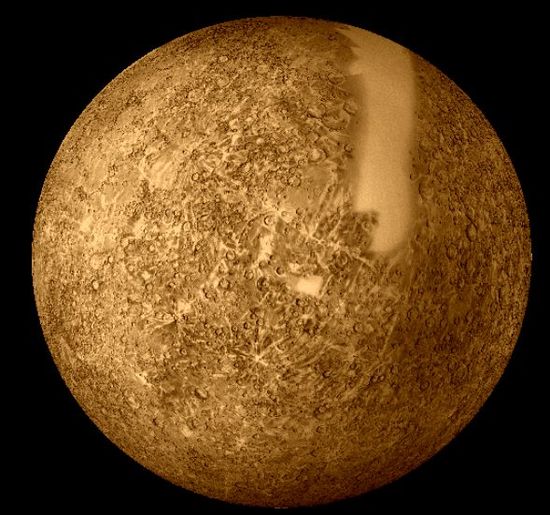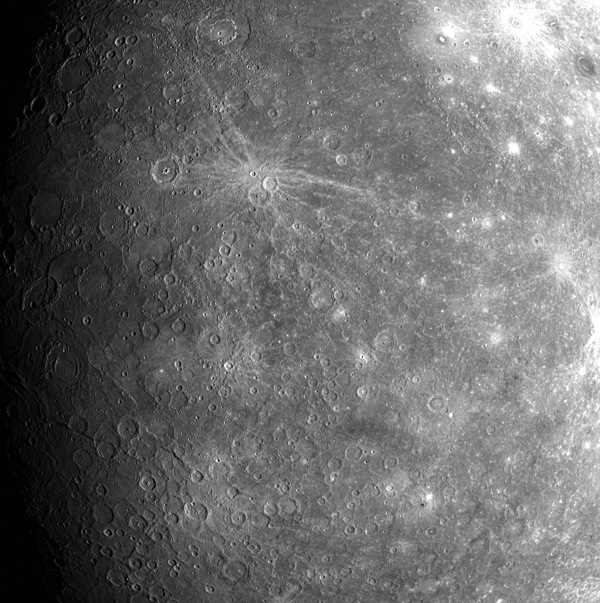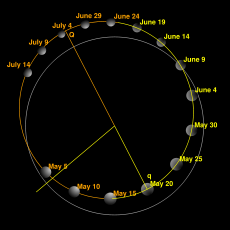





Become a fan on
Facebook
Folow author on:
facebook
twitter


Design by kakapo | copyright 2010 | Disclaimer
The First Planet
Mercury is the innermost and smallest planet in the Solar System, orbiting the Sun once every 87.969 days. The orbit of Mercury has the highest eccentricity of all the Solar System planets, and it has the smallest axial tilt. It completes three rotations about the axis for every two orbits. The perihelion of Mercury's orbit precesses around the Sun at an excess of 43 arcseconds per century; a phenomenon that was explained in the 20th century by Albert Einstein's General Theory of Relativity. Mercury is bright when viewed from Earth, ranging from -2.3 to 5.7 in apparent magnitude, but is not easily seen as its greatest angular separation from the Sun is only 28.3°. Since Mercury is normally lost in the glare of the Sun, unless there is a solar eclipse, Mercury can only be viewed in morning or evening twilight.

Above: The Mercury
Comparatively little is known about Mercury; ground-based telescopes reveal only an illuminated crescent with limited detail. The first of two spacecraft to visit the planet was Mariner 10, which mapped about 45% of the planet’s surface from 1974 to 1975. The second is the MESSENGER spacecraft, which mapped a further 30% during its flyby of January 14, 2008. MESSENGER's last flyby took place in September 2009 and it is scheduled to attain orbit around Mercury in 2011, where it will begin mapping the rest of the planet.

Mercury is similar in appearance to the Moon: it is heavily cratered with regions of smooth plains, has no natural satellites and no substantial atmosphere. However, unlike the moon, it has a large iron core, which generates a magnetic field about 1% as strong as that of the Earth. It is an exceptionally dense planet due to the large relative size of its core. Surface temperatures range from about 90 to 700 K (-183 °C to 427 °C, -297 °F to 801 °F), with the subsolar point being the hottest and the bottoms of craters near the poles being the coldest.
Recorded observations of Mercury date back to at least the first millennium BC. Before the 4th century BC, Greek astronomers believed the planet to be two separate objects: one visible only at sunrise, which they called Apollo; the other visible only at sunset, which they called Hermes.
Above: The surface of the Mercury
The English name for the planet comes from the Romans, who named it after the Roman god Mercury, which they equated with the Greek Hermes. The astronomical symbol for Mercury is a stylized version of Hermes' caduceus.
Mercury is one of four terrestrial planets in the Solar System, and is a rocky body like the Earth. It is the smallest planet in the Solar System, with an equatorial radius of 2,439.7 km. Mercury is even smaller—albeit more massive—than the largest natural satellites in the Solar System, Ganymede and Titan. Mercury consists of approximately 70% metallic and 30% silicate material. Mercury's density is the second highest in the Solar System at 5.427 g/cm3, only slightly less than Earth’s density of 5.515 g/cm3. If the effect of gravitational compression were to be factored out, the materials of which Mercury is made would be denser, with an uncompressed density of 5.3 g/cm3 versus Earth’s 4.4 g/cm3.
Craters on Mercury range in diameter from small bowl-shaped cavities to multi-ringed impact basins hundreds of kilometers across. They appear in all states of degradation, from relatively fresh rayed craters to highly degraded crater remnants. Mercurian craters differ subtly from lunar craters in that the area blanketed by their ejecta is much smaller, a consequence of Mercury's stronger surface gravity.
Mercury has the most eccentric orbit of all the planets; its eccentricity is 0.21 with its distance from the Sun ranging from 46 to 70 million kilometers. It takes 88 days to complete an orbit. A solar day on Mercury lasts about 176 Earth days, which is about twice as long as Mercury's orbital period, roughly 88 Earth Days. As a result, a Mercury year is about 0.5 Mercury days long, and one Mercury day lasts approximately two Mercury years. The first spacecraft to visit Mercury was NASA’s Mariner 10 (1974–75). The spacecraft used the gravity of Venus to adjust its orbital velocity so that it could approach Mercury. Before Pluto was discovered, there were 8 planets in the Solar System; and Mercury was the smallest. And then in 1930, the discovery of Pluto brought that number up to 9.

For most of the 20th century, scientists weren't sure which was bigger, Pluto or Mercury. But accurate measurements helped scientists conclude that Pluto was the smaller planet. And then in 2006, astronomers voted to remove Pluto as a planet, and so we've got back to 8 planets. And once again, Mercury is the smallest planet in the Solar System.
Above: Orbit of the Mercury




